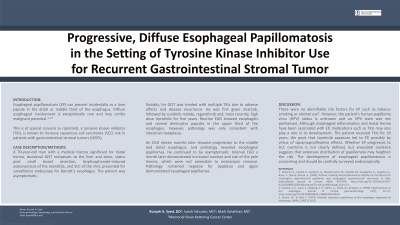Monday Poster Session
Category: Esophagus
P1873 - Progressive, Diffuse Esophageal Papillomatosis in the Setting of Tyrosine Kinase Inhibitor Use for Recurrent Gastrointestinal Stromal Tumor
Monday, October 23, 2023
10:30 AM - 4:15 PM PT
Location: Exhibit Hall

Has Audio
- KS
Kunzah A. Syed, DO
Johns Hopkins Hospital
Baltimore, MD
Presenting Author(s)
Kunzah A. Syed, DO1, Isaiah Schuster, MD2, Mark Schattner, MD3
1Johns Hopkins Hospital, New York, NY; 2St. Francis Hospital, Roslyn, NY; 3Memorial Sloan Kettering Cancer Center, New York, NY
Introduction: Esophageal papillomatosis (EP) can present incidentally as a lone papule in the distal or middle third of the esophagus. Diffuse esophageal involvement is exceptionally rare and may confer malignant potential. This is of special concern as ripretinib, a tyrosine kinase inhibitor (TKI), is known to increase squamous cell carcinoma (SCC) risk in patients with gastrointestinal stromal tumors (GISTs).
Case Description/Methods: A 70-year-old man with a medical history significant for hiatal hernia, duodenal GIST metastatic to the liver and bone, status post small bowel resection, bisphosphonate-induced osteonecrosis of the mandible, and SCC of the shin, presented for surveillance endoscopy for Barrett’s esophagus. The patient was asymptomatic. Notably, his GIST was treated with multiple TKIs due to adverse effects and disease recurrence. He was first given imatinib, followed by sunitinib malate, regorafenib and, most recently, high dose ripretinib for five years. Routine EGD showed esophagitis and several diminutive papules in the upper third of the esophagus, however, pathology was only consistent with intestinal metaplasia. EGD eleven months later showed progression to the middle and distal esophagus, and pathology revealed esophageal papillomas. He continued to be asymptomatic. Interval EGD a month later demonstrated increased number and size of the pale lesions, which were not amenable to endoscopic removal. Pathology remained negative for dysplasia and again demonstrated esophageal papillomas.
Discussion: There were no identifiable risk factors for EP such as tobacco smoking or alcohol use. However, the patient's human papilloma virus (HPV) status is not known and an HPV stain was not performed. Although esophageal inflammation and hiatal hernia have been associated with EP, medications such as tyrosine kinase inhibitors may also play a role in its development. The patient received TKIs for 20 years. We posit that ripretinib exposure led to EP, possibly by virtue of squamoproliferative effects. Whether EP progresses to SCC over time is not clearly defined, but anecdotal evidence suggests that extensive distribution of papillomata may heighten the risk. The development of esophageal papillomatosis is concerning and should be carefully surveyed endoscopically.
Disclosures:
Kunzah A. Syed, DO1, Isaiah Schuster, MD2, Mark Schattner, MD3. P1873 - Progressive, Diffuse Esophageal Papillomatosis in the Setting of Tyrosine Kinase Inhibitor Use for Recurrent Gastrointestinal Stromal Tumor, ACG 2023 Annual Scientific Meeting Abstracts. Vancouver, BC, Canada: American College of Gastroenterology.
1Johns Hopkins Hospital, New York, NY; 2St. Francis Hospital, Roslyn, NY; 3Memorial Sloan Kettering Cancer Center, New York, NY
Introduction: Esophageal papillomatosis (EP) can present incidentally as a lone papule in the distal or middle third of the esophagus. Diffuse esophageal involvement is exceptionally rare and may confer malignant potential. This is of special concern as ripretinib, a tyrosine kinase inhibitor (TKI), is known to increase squamous cell carcinoma (SCC) risk in patients with gastrointestinal stromal tumors (GISTs).
Case Description/Methods: A 70-year-old man with a medical history significant for hiatal hernia, duodenal GIST metastatic to the liver and bone, status post small bowel resection, bisphosphonate-induced osteonecrosis of the mandible, and SCC of the shin, presented for surveillance endoscopy for Barrett’s esophagus. The patient was asymptomatic. Notably, his GIST was treated with multiple TKIs due to adverse effects and disease recurrence. He was first given imatinib, followed by sunitinib malate, regorafenib and, most recently, high dose ripretinib for five years. Routine EGD showed esophagitis and several diminutive papules in the upper third of the esophagus, however, pathology was only consistent with intestinal metaplasia. EGD eleven months later showed progression to the middle and distal esophagus, and pathology revealed esophageal papillomas. He continued to be asymptomatic. Interval EGD a month later demonstrated increased number and size of the pale lesions, which were not amenable to endoscopic removal. Pathology remained negative for dysplasia and again demonstrated esophageal papillomas.
Discussion: There were no identifiable risk factors for EP such as tobacco smoking or alcohol use. However, the patient's human papilloma virus (HPV) status is not known and an HPV stain was not performed. Although esophageal inflammation and hiatal hernia have been associated with EP, medications such as tyrosine kinase inhibitors may also play a role in its development. The patient received TKIs for 20 years. We posit that ripretinib exposure led to EP, possibly by virtue of squamoproliferative effects. Whether EP progresses to SCC over time is not clearly defined, but anecdotal evidence suggests that extensive distribution of papillomata may heighten the risk. The development of esophageal papillomatosis is concerning and should be carefully surveyed endoscopically.
Disclosures:
Kunzah Syed indicated no relevant financial relationships.
Isaiah Schuster indicated no relevant financial relationships.
Mark Schattner: Boston Scientific – Consultant. Mirai Medical – Consultant. Novo Nordisk – Consultant.
Kunzah A. Syed, DO1, Isaiah Schuster, MD2, Mark Schattner, MD3. P1873 - Progressive, Diffuse Esophageal Papillomatosis in the Setting of Tyrosine Kinase Inhibitor Use for Recurrent Gastrointestinal Stromal Tumor, ACG 2023 Annual Scientific Meeting Abstracts. Vancouver, BC, Canada: American College of Gastroenterology.
